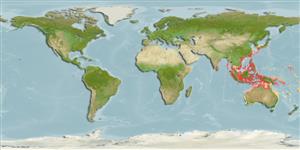Environment: milieu / climate zone / depth range / distribution range
पारिस्थितिकी
समुद्री प्रवाल-भित्ति संयुक्त; गहराई सीमा 20 - 40 m (Ref. 559). Tropical
Western Pacific: southern Japan southward. Reported from the Indian Ocean (Ref. 45255). Randall & Pyle (2000, Ref. 48242) note that Pseudanthias manadensis has not been convincingly linked to any species recognized today.
आकार / वज़न / Age
Maturity: Lm ? range ? - ? cm
Max length : 9.5 cm SL पुल्लिंग / अलिंग; (Ref. 559)
Highly variable in color. Females have an orange to red spot on the back, centrally at the base of the spinous dorsal-fin, that elongates in larger individuals and males. In some males it shows as a yellow bar and some large individuals have extended tips on the caudal fin (Ref. 48635).
Inhabits rocky reefs. A deep water species, usually in depths over 40 m and appears to occur primarily on current-prone soft-bottom slopes (Ref. 48635).
Life cycle and mating behavior
परिपक्व अवधि | पुनरुत्पत्ति | मछलीऔ का अंडे देना | अंडे | Fecundity | लार्वा
Masuda, H., K. Amaoka, C. Araga, T. Uyeno and T. Yoshino, 1984. The fishes of the Japanese Archipelago. Vol. 1. Tokai University Press, Tokyo, Japan. 437 p. (text). (Ref. 559)
IUCN Red List Status (Ref. 130435)
Threat to humans
Harmless
Human uses
अधिक जानकारी
आम नामउपशब्दचपायचयपरभक्षीईकोटोकसीकोलौजीपुनरुत्पत्तिपरिपक्व अवधिमछलीऔ का अंडे देनाSpawning aggregationFecundityअंडेEgg development
संदर्भजलीयकृषिजलीयकृषि रूपरेखाखींचआनुवंशिकीElectrophoresesहैरेटिबिलटीबीमारीप्रक्रमणNutrientsMass conversion
साधन
Special reports
Download XML
इंटरनेट स्रोत
Estimates based on models
Preferred temperature (Ref.
123201): 24.2 - 28.5, mean 28 °C (based on 93 cells).
Phylogenetic diversity index (Ref.
82804): PD
50 = 0.5000 [Uniqueness, from 0.5 = low to 2.0 = high].
Trophic level (Ref.
69278): 3.4 ±0.4 se; based on size and trophs of closest relatives
लौटाव (Ref.
120179): ऊंचा, न्यूनतम जनसंख्या दुगनी समय अवलागत 15 महीने। (Preliminary K or Fecundity.).
Fishing Vulnerability (Ref.
59153): Low vulnerability (10 of 100).
